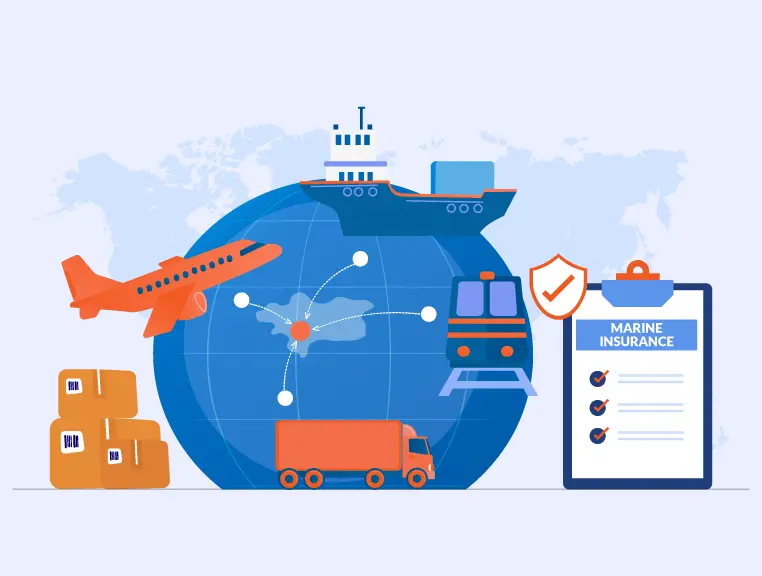Air freight is the term for when there is a shipment of goods or cargo via an air carrier. For this reason, air cargo is another common term for air freight. It is very important as it enables the transport of express shipments across the world. Often the transport of cargo across the globe takes place over maritime journeys. Air transport is a preferable option when goods need express transport without delay. It uses the same gateways as a passenger or commercial airline. This article focuses on different air transportation facilities available throughout the globe and insurance covers for the same.
The meaning of air freight
Importers/exporters hire air transport services to move shipments by an air carrier. The amount of money they pay for the air transport service is air freight.
Air freight – General statistics and costs
- The International Air Transport Association (IATA) is a trade association of all airlines in the world.
- Their study in July 2022 reveals that air freight transports goods worth 6 trillion USD per year.
- This statistic accounts for approximately 35% of global trade by value.
- During the Covid pandemic, air freight covered one-third of the revenue for airlines.
- Today, air freight is near 2019 levels, lesser than the very high 2020–2021 levels.
- The spring of 2020 saw record-high rates of air freight internationally.
- In 2019, air freight from the US to foreign countries cost 6.7 million USD.
- Air freight costs 12–16 times more than sea transport and 4–5 times more than road transport.
- International rates for air freight may range from $2.50–5.00 per kg.
- International air freight rates can go as high as $8 per kg.
- Air carriers charge by actual weight or volumetric weight, whichever is higher.
Types of cargo transported via air
Two factors influence the choice to transport goods by air:
- Value of the goods
- Urgency of shipment
High-value commodities or urgent materials require speedy shipment by air. It is also ideal for goods requiring speedy transport, like fresh food and cut flowers. Nowadays, there is greater demand for healthcare and pharmaceutical goods requiring air transport.
Air cargo falls under two broad types—general cargo and special cargo.
- General cargo is goods that do not need special handling or extra precautions during transit. Retail and most consumer goods fall under this category. This excludes electronic gadgets like mobile phones, tablets, and laptops. Other such goods under this type are hardware, textiles, dry goods, and more.
- Special cargo is goods having special requirements. These requirements are for their packaging, labelling, documentation, and handling during transit. There are special regulations governing the shipment of these goods. Live animals, perishable cargo, dangerous goods, and wet cargo fall under this category. Temperature and time-sensitive goods also come under this category.
Risks involved in air freight
Some of the risks involved in air freight are:
- Airlines, handling agents, and stakeholders in the supply chain not adhering to the regulations for the cargo. This can lead to loss and damage to the goods.
- Perishable items may spoil if there is improper temperature management during transit.
- Security threats such as hijacking put crew and cargo at risk.
- Concealment of explosives undergoing transport via air cargo.
- Inadequate implementation of risk-based targeting measures for detecting suspicious cargo.
- Close collaboration by governments, airports, and air carriers to ensure the security of the cargo.
Air cargo insurance
Air cargo insurance covers buyers or sellers of goods against the loss or damage of goods during air transport. It reimburses the policyholder for damaged or lost insured items. It may even offer compensation for goods facing shipment delays.
Features and benefits of air cargo insurance
- Air cargo insurance is not required by law.
- It offers financial protection in case of damage or loss of the cargo.
- Some insurers offer reimbursement in case of unexpected delays in the delivery of goods.
- It may cover the costs of replacing the damaged or lost cargo.
- There are limits on air carrier liability. Liability is usually only $24 per kg for air cargo carriers.
- Insurers may offer comprehensive air cargo insurance. Here, they reimburse the goods’ invoice value plus the freight costs.
- Insurance coverage starts from the time the goods take off until they reach their destination.
- It protects the cash flow of buyers and sellers from unexpected interruptions.
- Air cargo insurance offers peace of mind to buyers and sellers in the face of unforeseen risks.
- This insurance protects the reputation and revenue of businesses. It compensates them in the event of unforeseen incidents.
- Air cargo insurance usually has flexible insurance rates specific to the cargo and coverage needs.
- It covers natural disasters like lightning, cargo abandonment, vehicle accidents, customs refusal, acts of war, piracy, and more.
- Air cargo insurance has fewer exclusions compared to other insurance types.
- The policyholder does not have to prove that the fault of damage or loss lies in the carrier.
- Reporting loss or damage for air cargo insurance is convenient.
- It has an easier claim application procedure compared to other insurance types.
Air cargo insurance premiums
Air cargo insurance does not have a fixed type of insurance premiums. Rather they vary on the basis of different factors. Air cargo insurance policyholders can optimise their insurance coverage according to their specific requirements.
The factors influencing the premium rates for air cargo insurance are
- The level of coverage the insurance policy offers
- The nature of the insured goods
- The invoice value of the insured goods
- The route the air carrier will take for the air service transport
- The final destination of the insured goods
- Any additional coverage the policyholder wants
- Size of the policyholder’s business.
Exclusions under air cargo insurance
The following are the common exclusions under air cargo insurance:
Inherent vice
Here the damage arises from the physical nature and condition of the goods. There is an internal cause for the damage. So, the damage does not arise from any fault of the supply chain process.
Latent defect
This is when an inspection does not reveal any problems with the product. The cause of the damage here is the lower quality of goods. For example, improper manufacturing leads to cracks in a product.
Improper packaging
Careful packaging is crucial for air cargo, especially in the case of special air cargo. If the shipper fails to package the goods properly, it can result in damage while in transit. For example, a shipper tries to save on costs by reusing corrugated boxes. Improper packaging results in losses that air cargo insurance will not cover.
Wilful misconduct by the insured party
Air cargo insurance does not cover losses and damages resulting from wilful misconduct by the insured party and their employees. This is essentially insurance fraud.
Claims settlement
Most carriers have limited liability when it comes to insurance claims. So, the policyholder must prove that the loss or damage took place when the goods were out of their hands. For this, the policyholder must provide the following details:
Inventory number:
The insurer provides the number on the inventory list. The policyholder has to provide this number when making a claim.
Item’s room:
This refers to the location of the goods before packaging takes place.
Item description:
The policyholder must provide all descriptive information about the insured goods. This includes weight, visual cues, dimensions, and accessories.
Damage:
The policyholder must give a detailed description of the damage or loss.
Date and age of the item:
If the policyholder has production records, they must provide the same to the insurer. Otherwise, they give educated guesses about the age of the item and purchase date.
Major differences between marine, air cargo, and inland transit insurance
Here are the major differences between marine, air cargo, and inland transit insurance:
| Marine insurance | Inland transit insurance | Air cargo insurance | |
| Definitions | Covers the cost of damages to import/export goods via different modes of transport. Includes coverage for the vessel and damage to ports | Covers the goods undergoing transport over land | Covers the goods undergoing transport by air transport services |
| Transportation modes | Includes sea, road, rail, or air transportation modes | Transport via trucks or trains, and so on, only | Only covers transport via air carrier |
| Geographical location | Covers the transport of goods internationally | Covers goods undergoing domestic transport | Can cover both international and domestic transport of goods
|
| Who avails of this insurance? | Large-scale businesses and multinational companies that import/export finished goods and raw materials | Small to mid-scale businesses that do not partake in the import/export of goods | Mid to large-scale businesses that may or may not partake in the import/export of goods |
How to buy air cargo insurance?
To buy air cargo insurance, complete a risk assessment by our experts for your next consignment. Choose from the best insurance policies provided by different insurers for covering your air freight.
About The Author
Simran
MBA Insurance and Risk
With extensive experience in the insurance industry, Simran is a seasoned writer specializing in articles on marine insurance for SecureNow. Drawing from 5 years of expertise in the field, she possesses a comprehensive understanding of the complexities and nuances of marine insurance policies. Her articles offer valuable insights into various aspects of marine insurance, including cargo protection, hull insurance, and liability coverage for marine-related risks. Renowned for their insightful analysis and informative content, Simran is committed to providing readers with actionable information that helps them navigate the intricacies of marine insurance with confidence.





